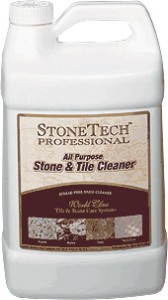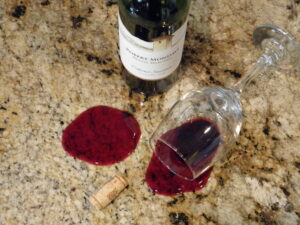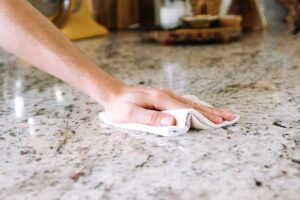- Products
- Stuff You
Should Read
- I Am Ready For
Tops When...
- Contact Us
Stone Care Guide
Your new natural stone purchase is an investment in lasting beauty that will give you many years of enjoyment. This care guide gives you a few tips on how to properly care for your natural stone and help extend its life and beauty. Following some simple procedures and using the correct cleaning methods and products will ensure you a lifetime of enjoyment from your natural stone.
SEALING YOUR STONE
Natural stone has been formed over millions of years, but improper care can ruin nature’s beauty in a matter of months. Although we usually think of stone as “hard,” it is a porous material that can absorb spills and stains when left untreated. Sealing your stone is a vital part of the installation process.
At MarbleWorks, we apply a quality impregnating sealer to all the stone we install that prevents most spills from damaging your investment. Once sealed properly, your stone is protected against everyday dirt and spills. Also, proper cleaning methods are vital to help the sealer last longer and keep your stone protected without damaging your stone’s natural beauty.
CLEANING PROCEDURES & RECOMMENDATIONS 
Using a neutral cleaner specially formulated for natural stone will help remove soils that normal dusting or damp cleaning leave behind. We recommend Revitalizer Cleaner with Protector. This cleaner is developed especially for natural stone and tile care. Its unique blend of neutral cleaning agents makes it gentle on your stone while leaving behind an impregnating protective shield every time you clean.
Do NOT use general purpose cleaners or you may damage your stone or break down the sealer.
Do NOT use products that contain lemon, vinegar or other acids as these may etch the stone surface and damage the polish.
Do NOT use scouring powders or creams; these products contain abrasives that may scratch the surface.
Acids Can Etch Into Your Stone If Not Properly Cleaned & Revitalized
Use Revitalizer on a regular basis to remove residues from cooking oils and everyday food spills. Many common foods and drinks contain acids that may etch or dull the stone surface. In the bathroom, some common spills are hairspray, cosmetics, toiletries (perfume, toothpaste, mouthwash, etc.). These may contain acids and other ingredients that will damage your stone surface or degrade its sealer. It is important that these spills be removed from the stone as soon as possible.
In the shower and other wet areas, the use of Revitalizer will remove any soap scum or hard water deposits that may have formed. Also, using a squeegee or sponge after each use can minimize soap scum and hard water deposit buildup.
Dust mop interior stone floors frequently using a clean, non-treated dry dust mop. Sand, dirt and grit do the most damage to natural stone surfaces due to their abrasiveness. Mats or area rugs inside and outside an entrance will help to minimize the potential damage from these particles. In addition, be careful when using a vacuum cleaner, as the metal or plastic attachments or wheels may scratch the surface. Damp mop the stone floor with clear water as needed. For cleaning, use a diluted solution of Revitalizer or CleanStone as directed on the label. Keep off floor until completely dry, as wet stone floors may be slippery and cause falls.
WHAT TO DO WHEN A SPILL OCCURS
No matter how careful you are, spills are going to happen. A quick response and the right solutions can keep spills from damaging your stone or the sealer. We recommend that you only use the cleaning products recommended in this care guide.
FOOD SPILLS – Scoop up the food with a plastic spoon. Blot with dry, white cloth. Spray area with
Revitalizer. Wipe dry with a clean cloth.
LIQUID SPILLS — Blot away the excess with a clean, dry, white cloth, turning the cloth frequently. Spray area with Revitalizer. Wipe dry with a clean cloth.
OILY STAINS — If you identify the stain as having an oil base (from foods like salad and cooking oils, butter, or some cosmetics) you may be able to remove the stain using a poultice. We recommend EXTRACT OIL STAIN REMOVAL PASTE. This easy to use poultice is designed to slowly remove oily stains from natural stone surfaces. This product may be purchased from us. Follow the directions on the label.
MUD — Let the mud stain dry completely. Remove dried mud with a soft plastic or nylon brush. Spray affected area with Revitalizer. Wipe dry with a clean cloth. If the stain remains, contact a professional cleaner.
ETCH MARKS — Substances that are highly acidic, such as orange juice, coffee, vinegar, wine, tomato products, mustard and many soft drinks will “etch” some stones, such as polished marble— even if they are sealed. Although sealing allows you time to wipe up a spill, it cannot stop the chemical reaction that may leave a dull area or etch mark in the stone, although we use the best sealer we can find to prevent this as best we can. In addition, cleaners not specifically designed for natural stone are not recommended. These may etch away the polish, discolor the surface, scratch the stone or degrade the sealer. That’s why selecting the correct cleaning products is so important to the lifetime beauty of your natural stone. Professional refinishing is the best way to permanently remove etch marks and restore your natural stone’s finish.

